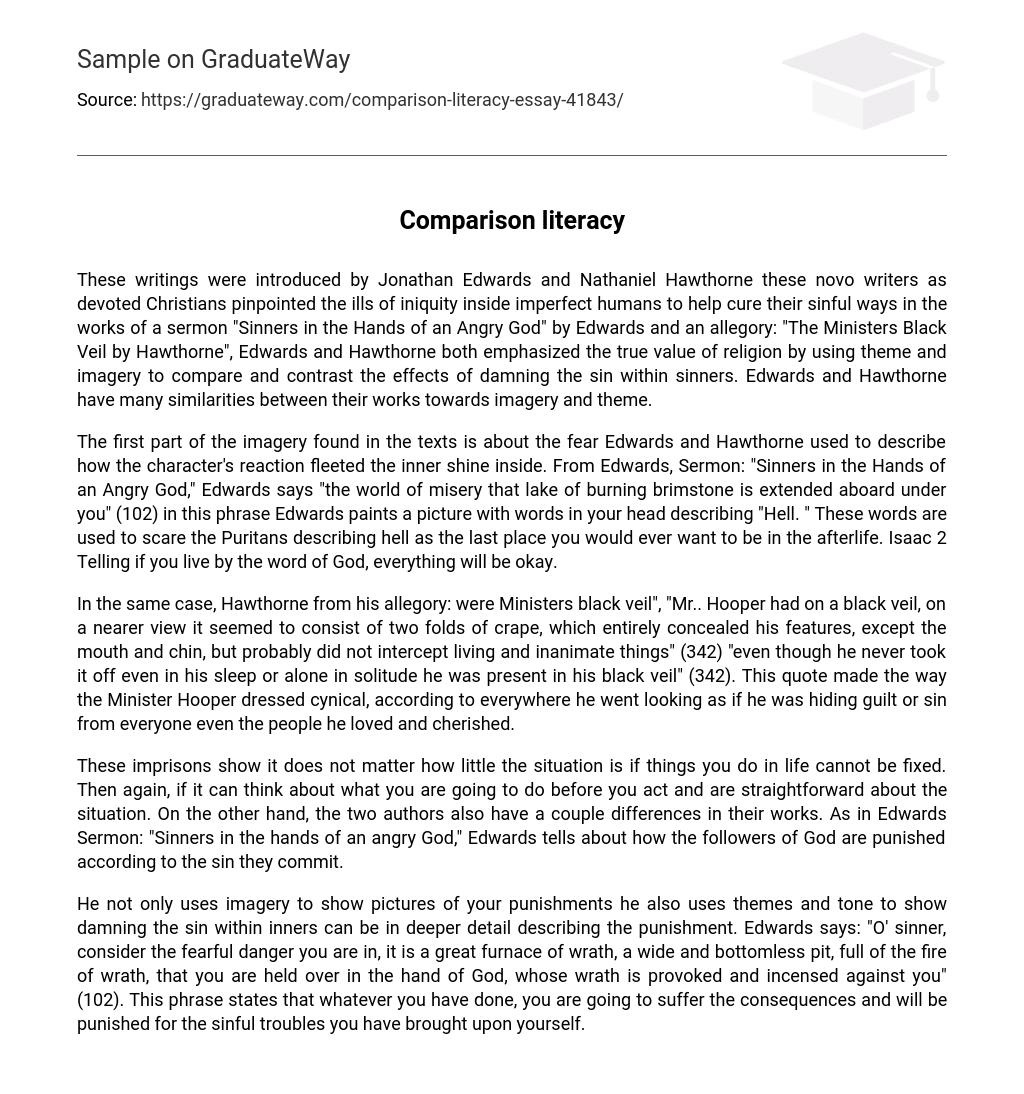These writings were introduced by Jonathan Edwards and Nathaniel Hawthorne these novo writers as devoted Christians pinpointed the ills of iniquity inside imperfect humans to help cure their sinful ways in the works of a sermon “Sinners in the Hands of an Angry God” by Edwards and an allegory: “The Ministers Black Veil by Hawthorne”, Edwards and Hawthorne both emphasized the true value of religion by using theme and imagery to compare and contrast the effects of damning the sin within sinners. Edwards and Hawthorne have many similarities between their works towards imagery and theme.
The first part of the imagery found in the texts is about the fear Edwards and Hawthorne used to describe how the character’s reaction fleeted the inner shine inside. From Edwards, Sermon: “Sinners in the Hands of an Angry God,” Edwards says “the world of misery that lake of burning brimstone is extended aboard under you” (102) in this phrase Edwards paints a picture with words in your head describing “Hell. ” These words are used to scare the Puritans describing hell as the last place you would ever want to be in the afterlife. Isaac 2 Telling if you live by the word of God, everything will be okay.
In the same case, Hawthorne from his allegory: were Ministers black veil”, “Mr.. Hooper had on a black veil, on a nearer view it seemed to consist of two folds of crape, which entirely concealed his features, except the mouth and chin, but probably did not intercept living and inanimate things” (342) “even though he never took it off even in his sleep or alone in solitude he was present in his black veil” (342). This quote made the way the Minister Hooper dressed cynical, according to everywhere he went looking as if he was hiding guilt or sin from everyone even the people he loved and cherished.
These imprisons show it does not matter how little the situation is if things you do in life cannot be fixed. Then again, if it can think about what you are going to do before you act and are straightforward about the situation. On the other hand, the two authors also have a couple differences in their works. As in Edwards Sermon: “Sinners in the hands of an angry God,” Edwards tells about how the followers of God are punished according to the sin they commit.
He not only uses imagery to show pictures of your punishments he also uses themes and tone to show damning the sin within inners can be in deeper detail describing the punishment. Edwards says: “O’ sinner, consider the fearful danger you are in, it is a great furnace of wrath, a wide and bottomless pit, full of the fire of wrath, that you are held over in the hand of God, whose wrath is provoked and incensed against you” (102). This phrase states that whatever you have done, you are going to suffer the consequences and will be punished for the sinful troubles you have brought upon yourself.
Isaac 3 On the other hand, Hawthorne used point of view texts in his allegory:” The Ministers black veil,” when Mr.. Hooper is talking to his fiance, when she asked him to take away the veil and to look her in the face, he responded “no, this veil is a symbol, and I am bound to Wear it ever, both in light and darkness, in solitude and before the gaze of multitudes, and as with strangers, so with my familiar friends” (28 – 29). Mr.. Hooper also admits that he has signed on “if it be a sign of mourning l, perhaps, like most other mortals, have sorrows dark enough to be typified by a black veil” (28).
This phrase stated that even the losses person he loved and cherished could not see his face not even in a matter of life and death being that this sin was so bad it would never be removed under any circumstances. These differences between the two authors had the audience in wonder and shock in the way something so little like a veil could cause such a catastrophe of friends and lovers no matter how big or little the sin was. Despite the use of similar theme: “Damning the sin within sinners,” the two authors approach the text differs in point of view awards the sink in sinners and value of religion.
Both authors pinpointed the ills of iniquity inside imperfect humans to help cure their sinful ways of the influence of the Puritan beliefs and Christian ways. However, Edwards talked about the ways the followers of God are punished against the sins they commit by the assertive tone of fear and desperation. While Hawthorne introduced tones of melancholy, mystery, perplexes and regretful words about the past, about the sins in one that caused a downfall in a relationship twine two lovers just by the reverent beliefs of a black veil.





